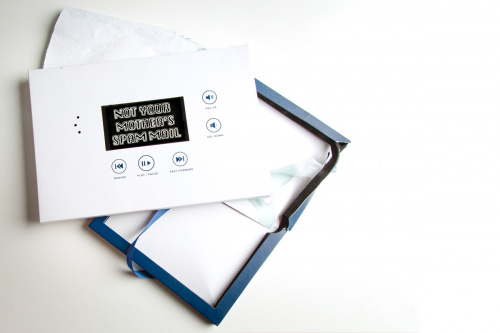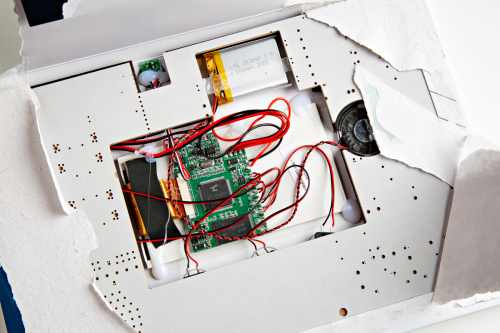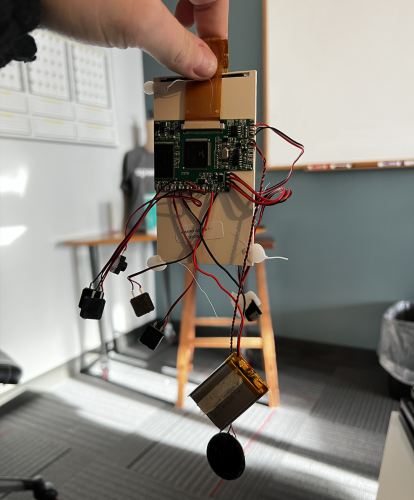Today's blog features a closer look at a piece of spam mail sent to Nathan a few months ago. But this ain't your mother's spam mail - they really went all out with this one. First of all, the mail felt really heavy, unnaturally so. Upon opening, the package contained a video mailer playing a minute-long ad from GrowTeam, a marketing company we've never contacted nor dealt with.
We figured we might as well take this thing apart and see what's up with it. We found little metal pieces in the bigger envelope to give heft to it, but didn't relate to any actual content. However, what was inside was even more interesting - a video mailer.
This is a full video player, fit with a screen and speaker, that played this company's commercial immediately upon opening it. Stock footage of people dressed in business professional walking in and out of offices with inspirational orchestral swells in the background and a voiceover with the company's elevator pitch. We tore open the packaging to look at the hardware, and here's what we found:
We'd never seen this type of mail before, and it seemed odd to us that a company would send out something equivalent to junk mail that was so expensive, wasteful and bothersome to whoever opened it. So we did some further research.
Turns out, video mailer marketing is a thing, and sending one out can cost you around $24. There are companies that manufacture these, letting you customize it as you wish but working off the same template.
One of the companies we found in our research is called Marc, and we were particularly interested in them because of their claims about their analytics. Their website states that they can tell customers how many times their mailers have been opened, which means there's something in the mailer transmitting data back to them (if they're telling the truth). Kind of creepy, especially since you have no idea if the data collection truly stops there.
We were wondering what technology the mailer used to do this, so we tore it apart. Here's what the inside looked like uncovered:
The hardware list is pretty standard at first: buttons behind the playback controls, battery and micro-usb port to re-charge, speaker for the audio. However, when getting to the controls, things got more interesting. the main board contains a 2GB NAND flash chip from SK Hynix. Driving the media playback was the Actions ATJ229R1 media player chip. Here's the datasheet for that one if anyone's interested. We didn't find anything transmitting data, which means GrowTeam probably got this mailer from a different company that sends video mailers (there's many of them!).
no mercy was shown with disassembly
We were glad about that, but looking into this world of video mailers raised a lot of questions for us. The data transmission aspect is concerning for anyone conscious of data privacy or worried about OTA hacks of any kind. The design and price seems over-engineered and wasteful, especially for junk mail.
Are video mailers popular, and do people actually respond to them? Is grabbing attention enough, as they clearly did with us? Is the age of email promotions coming to an end due to oversaturation, and am I going to end up drowing in a mountain of video mailers instead of 60,000 unread emails in my promotions inbox? Who's to say!
We want to know what you think! Have you ever received a video mailer? What was your reaction to it? What did you do with it?













Just got one of these in the mail manufactured by from Marc Media. It contains a Quectel BG95-M3 celluar board, a Miot 3v042B antenna and an AT&T sim. It plugs in via USB and goes into charge mode .... I'm still trying to figure out how to get new content onto it.
I was surprised that with today's level of regulation of LiPo, etc. batteries, no one commented on recycling, let alone, the requirements for mailing something like this is literally illegal if it doesn't have the proper "battery inside" warning. After all, these types of batteries are "known to explode", although I haven't heard much in the news lately about that, but then maybe it's become "too "ordinary to report? But it breaks a federal law without that label. It also seems to have been designed and built poorly. Also, the above link to the media player's website generated Chrome's "not secure" warning, so any personal info entered on that website may be compromised.
This type of prospecting can be found in highly lucrative verticals, especially when there are commissions involved. If it costs you $1,000 to earn $50K+ annually, it's money well spent.
I'm a recovering marketer and in the early 00's (before smart phones) I had a client who sold supplementary health and disability insurance to large customers. I set up a program for him using a cheap(ish) pre-paid Nokia phone in a custom box. He would include a handwritten note that said, "This phone will ring on Monday, December 4th at noon."
And every time he called, the prospect answered. The program was so successful, he maintained it for 3 years.
I did not charge accordingly for this program as he made millions and I...did not. 😉
So somebody is re-defining Spam to include non-email now. It was bad enough when anti-engineers who love to create more confusion by redefining words decided that a blog is both the name of a web log and each of the articles/posts on the weblog. Now they want to conflate physical mail with email.
Fascinating. I've never seen one, but it makes sense in a way. Expensive advertising is worth it when the return on investment is high. The originator of the mailer sent to you needs only one or two bites to make the campaign worth it-- if they sent out 500 of these things, costs would be recouped rapidly if they got even one or two new customers, because the revenue from just one new customer would be so high. Expensive advertising also works when the pitch is to a gatekeeper. Take doctors, for example--convincing a doc to change prescribing practices has a huge downstream effect. Again, getting one or two prescribers to change their favored medication for a given condition generates a big ROI. The prescriber, rather than the consumer, needs to be convinced to change, and an expensive pitch is very much worth it. It feels horribly wasteful, but anything that makes the reader or viewer stop and pause has value. The world is screaming at us through social media, emails, whatever. Gotta scream louder to be heard. Finally, privacy-- if a mailer can really tell the mother ship how many times it has been opened--unless it is doing so from a cellular chip in the mailer or using some other magic that doesn't use the recipient's network, this is very bad and depending upon the jurisdiction, might incur the sender civil or criminal liability. You can't use my network without my permission. A little bit of a rant, sorry, but I think I've gotten my points across.
I'd never even HEARD of this sort of thiing. I suspect that whoever bankrolled it was looking at a list of "business owners" (and probably sorted on something related to the dollar value of the business), and Nate's name popped up. I certainly agree that "high-end" marketiing can be worth the expense -- look at how many golf tournaments there are that get televised ... I can't recall being bored enough to watch one, but then again, I'm not likely to buy a Lexus or some other thing they're advertising.
I expect that the company that sent that out is definitely watching their "hit rate" on their website. I suspect that it's going to spike because of this blog post (if I weren't so busy today I'd fire up the VPN and give it a hit from some odd-ball place).
Anyway, many thanks to the folks at SparkFun for the post and to Maine Solder Guy for the insightful comments!
More information-- looked at the Marc website, and went to their privacy page. I've copied and pasted. So basically, it seems like if you want to look at it, you have to give permission to have your data collected. Yuk.
We value your privacy We appreciate the sensitivity of your data. Marc campaigns deliver first-person interactions with customers, thereby eliminating any third party data privacy concerns.
Additionally, our opt-in experience is transparent and simple. It starts with a privacy sticker affixed to the cover of the brochure. Once the device is opened, and customer interactions begin, the invitation to collect data is accepted.
For more information, please visit our privacy policy.
My first inclination, when I saw about the metal pieces "to give it heft", was to think I might have called the bomb squad. Maybe having them "detonate" it wouldn't be such a bad idea? ;-)